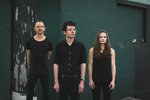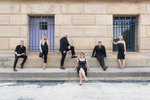First Presbyterian Church in Germantown will present a concert entitled “Virtue & Vice” Sunday, Feb. 12, at 3 p.m. Admission is free with a suggested donation.
This item is available in full to subscribers.
We have recently launched a new and improved website. To continue reading, you will need to either log into your subscriber account, or purchase a new subscription.
If you are a digital subscriber with an active subscription, then you already have an account here. Just reset your password if you've not yet logged in to your account on this new site.
If you are a current print subscriber, you can set up a free website account by clicking here.
Otherwise, click here to view your options for subscribing.
Please log in to continue |


First Presbyterian Church in Germantown, 35 W. Chelten Ave., will present a concert entitled “Virtue & Vice” Sunday, Feb. 12, at 3 p.m. Admission is free with a suggested donation accepted at the door.
The concert will be performed by two ensembles: Variant 6 and Filament Baroque. The former comprises sopranos Jessica Beebe and Rebecca Myers, mezzo Elisa Sutherland, tenors Steven Bradshaw and Daniel Taylor and bass Daniel Schwartz. The latter boasts violinists Evan Few and Mandy Wolman, violist da gamba Elena Kauffman, theorbo player Kevin Payne, and harpsichordist John Walthausen, who is the music director (organist & choirmaster) at First Presbyterian Church in Germantown.
The inspiration of “Virtue & Vice” is to explore the ways in which French composers at the turn of the 18th century wrote their sacred music. Particular focus will be placed on the moving and meditative “Litanies de la Vierge,” a dramatic telling of the martyrdom of the ancient Roman St. Cecilia by Marc-Antoine Charpentier. Also included will be a selection of New World spiritual songs that were collected and performed in the 1700s at the Ursuline Convent in New Orleans, Louisiana.
Walthausen, co-artistic director of Filament, explained, “The Ursuline Manuscript of New Orleans is without a doubt one of the most fascinating windows we have into music-making in 18th century North America. Sent by a father in France to his daughter in a New Orleans convent, it is a compelling compendium of music for the stage and chamber, re-imagined as spiritual songs for nuns living and working far from home. We can hardly wait to bring this music, as well as two major and rarely performed works of Charpentier, to a local audience.”
Sutherland, co-artistic director of Variant 6, added, “Charpentier’s music is so rarely performed in the United States. In ‘Virtue & Vice,’ we will showcase the breadth of his sacred writing, from the drama of his oratorio, ‘Caecili, virgo et martyr,’ to the breathless devotion found in the vocal writing of the ‘Litanies de la Vierge.’ Additionally, Variant 6 has wanted to collaborate with our good friends in Filament for a long time now; we hope this concert will bring together all of Philadelphia’s enthusiastic early music community.”
Piano Recital at Woodmere
Finnish-born but locally based pianist Marja Kaisla performed a pair of solo recitals at Chestnut Hill’s Woodmere Art Museum, Jan. 20 and 21. The first boasted a flashy program of music by Liszt, Brahms, Debussy and Stravinsky.
For the second, Kaisla opted for music of a more profound nature. Her all-Schubert program featured the Viennese master’s “Six Moments Musicaux,” Opus 94, and his “Sonata in B-flat major,” D. 960. The Sonata was his final effort in that form and wasn’t published until well after his death in 1828 at the tragic age of only 31 years.
I would have loved to have heard both recitals, but my teaching schedule at Settlement Music School in the city prohibited me from attending the first. I did, however, make it to the second and came away touchingly moved by the beauty of Schubert’s music and mightily impressed by Kaisla’s pianism and musicality.
The six movements of the “Moments Musicaux” span the gamut of moods, tempos, textures and emotions through an unfettered flow of lyricism that was the template of Schubert’s style and that has elevated him into the highest reaches of the pantheon of great classical composers. Even though the instrument for which he wrote was far different from the Kawai grand piano on which Kaisla played – far lighter in tone and touch – Schubert’s keyboard music continues to resonate in the hearts and souls of contemporary classical music lovers.
Kaisla projected the sweet melodiousness of the opening “Moderato” through a finely textured warm tone, the gentle lullaby personality of the “Andantino” via darker, more dramatic shades, the spikey staccatos of the “Allegro moderato,” the delicate filigree of the “Moderato,” the broader expanse of the “Allegro vivace” and the beguiling Viennese lilt of the closing “Allegretto.”
Throughout all six movements, Kaisla elicited a myriad of colors and textures to delineate the full panoply of Schubert’s fervent imagination. Her technical command over the Kawai grand piano was complete, and the natural musicality of her interpretations never lost its hypnotic integrity.
The “Sonata in B-flat major,” Opus Posthumous, remains one of the most daunting challenges in the piano’s standard repertoire. Its total duration reaches that notorious “heavenly length,” and that can prove troublesome for even the greatest keyboard titans of all time.
Kaisla caught the craggy profundity and towering spirituality of the score’s extended structure, with only the slightest flagging toward the fourth movement’s tumultuous finale. Permit me one small suggestion: skip the repeat of the exposition in the first movement.
‘Carmina Burana’
Although most local classical music lovers associate Carl Orff’s “Carmina Burana” with ballet companies (such as our own Philadelphia Ballet) that dance it regularly, it is originally a secular cantata that exists on its own as a concert choral work.
Opera Philadelphia will perform the original musical version Friday, Feb. 3, at 8 p.m. and Sunday, Feb. 5, at 2 p.m. at the Academy of Music. Lina Gonzalez-Granados will conduct. Visit www.operaphila.org for ticket information.
You can contact NOTEWORTHY at Michael-caruso@comcast.net.